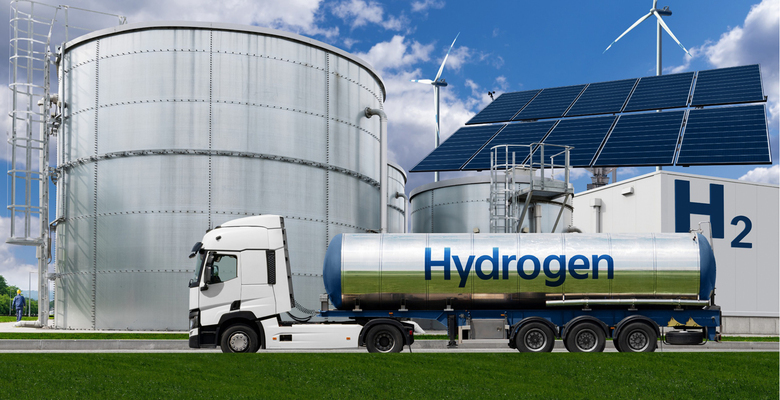
The climate crisis and the harmful effect of human activity on nature have long dominated the news, but in the last three years, the topic has become ever more urgent, polarising society and giving rise to a multitude of myths and conspiracy theories. Environmental pollution is directly driven by our consumption of energy resources, most of which, unfortunately, are finite and subject to geopolitical manipulation. It follows that the transition to new forms of energy is inevitable. What’s more, the energy transformation has already started.

What is the future of humanity’s energy needs? Why will hydrogen in particular be so important to us in the immediate future, and why is the existing energy grid no longer adequate? Has the hydrogen race already begun? Is this sphere worth investing in and where are new hydrogen technologies already being put to use? Denis Kalinin, the managing director of Hydrogen Deutschland, answered these questions and more in an interview with Kommersant UK.
What is the energy transformation?
It is a process that humankind has gone through before, and I hope it will go through again. The first use of fire, roughly 1.5 million years ago, could be called the first energy transition. Watermills appeared around 2,000 years ago, using the same principle as hydroelectric power stations. Engineering science and mathematics have made our lives much faster; in 1765, James Watt came up with the steam engine, which allowed the coal economy to develop. In 1892 Rudolf Diesel gave us the diesel engine, which was the starting point for the petroleum economy. In the 1950s technology was developed permitting natural gas to be extracted from deep deposits and transported across the great distances required for the gas industry. Also in this decade, in 1954, the USSR completed the first commercial, water-cooled reactor in Obninsk, which marked the beginning of civilian nuclear power.
It sounds great when you set it all out in that way, but to me as a non-specialist, it seems that these events are completely unrelated.
Well, why so? All these transformations share the same features. The first steam engine was considered very dangerous, and a special man was supposed to walk in front of the locomotive to warn people of its approach. The first diesel engines were regarded as toys for the rich, since they were very expensive, as was diesel fuel itself, which was initially sold in chemists. The first gas-fired power plant became operational in 1901 in Sweden, but it was only by 1950 that natural gas became an economically viable fuel. Energy transformations don’t occur because simpler and cheaper methods of producing energy have been found, but rather, all these transformations have led us to more complex and expensive forms of energy, which turned out to be more powerful, easier to distribute and more convenient to use.
Do you mean that a transformation can begin as a search for comfort?
In effect. The steam engine replaced the horse, making energy more stable, affordable and convenient to use. The diesel engine replaced the steam engine, making energy more powerful and compact. A small modern car engine produces approximately 200 horsepower. Gas has replaced coal, making our lives more comfortable, and removing the fumes, odours and mounds of coal from cities. A new global infrastructure has appeared of roads, pipelines, tanker terminals and airports. Altogether, this has led to a new global economic model which has allowed a new burst of industrialisation and globalisation, bringing with it a new middle class, making travel around the planet accessible to many, establishing a global economy and even creating some semblance of a peaceful life. These new economic ties have often become more important than political ones.
Then why disrupt such a hard-won balance?
Now we are on the cusp of a completely new transformative process; the transition to clean and renewable energy sources. The goal of this transition is to reduce dependence on the finite and polluting energy resources which are causing climate change. As early as the 2000s, and in some aspects even earlier, it became evident that the future direction of technological progress was unclear. Yes, the concept of small nuclear reactors had appeared, as the main problem with nuclear energy at the time was distribution, if you recall, rather than production. However, society viewed the idea of having more reactors at close proximity with some anxiety since they would contain dangerous “magic” metals. Consequently, strenuous attempts were made to put the nuclear question to rest. People wanted something simple, easy to understand and familiar, yet at the same time, convenient, clean and cheap. So a fashionable new word appeared; “sustainable” [The closest Russian equivalent, ustoychivy, means something like “long-lasting”]. Humankind had long realised that the natural world around us was changing, so the question of climate change began to come to the fore.
On the whole, most people agree that the climate is changing, but the furious debates about the causes are ongoing.
Yes, that’s right. Some say that we’re all going to die tomorrow and this is the last generation to live on the planet, while others say nothing too terrible is going to happen in the next million years or so and maybe everything will sort itself out of its own accord. It’s clear the truth is somewhere in between. Of course, nothing will happen right now, but we’re using millions of times more energy than 100 years ago and it seems we’ll be using billions of times more in another 100 years. These growing energy requirements demand new solutions to our energy supply problems. If we don’t find another way, we’ll keep on burning orders of magnitude more as time passes, which can’t be considered a farsighted strategy. Atomic energy is developing, but it can’t replace current energy sources for the reasons I’ve already mentioned.
Is a solution possible that will allow the current infrastructure and technology to be used, at least for the transitional period before we attain this sustainable world?
The main question it all boils down to is how we can turn away from hydrocarbons and make the transition to renewable energy as much as possible whilst minimising changes to the current infrastructure and remaining within acceptable cost limits. To do this, first, we need to make energy production and consumption clean, without greenhouse gas emissions or toxins which pollute the atmosphere and biosphere. It should be safe and it shouldn’t leave problems for a future generation to solve. The next step is to make this source renewable so that it doesn’t use up the resources of the planet, as, while our numbers are growing exponentially, there is only one world. Soil erosion and subsidence, flooding, contamination of aquifers and cancerogenic phenomena occur increasingly often. Actually, these two tasks are separate and must be tackled simultaneously.
That all sounds promising, but what will happen to the level of comfort we have grown accustomed to?
It’s important to maintain current comfort levels and even raise them as much as possible. The world has already become a global economy and we could probably even say a global culture, however much some politicians like to deny this. Politics is actively parting ways with economics, if not with real life itself. Politicians are required to resort to doublespeak, like in Orwell’s 1984. We’re monitoring with great interest politically hostile countries which are continuing to maintain trade links and agreements even while at war. The economy is actually replacing the political element of our culture. Almost the entire planet has heard of McDonald’s and Ikea.
For the man on the street, it may seem that the energy crisis appeared out of the blue along with Greta Thunberg. In reality, how long has this subject been discussed and are there any solutions?
This topic has been intensively researched for the last 25 years, for the first 20 of which progress was mostly theoretical. It was important to understand if an alternative to oil could be found. Over this time it became clear that it was possible to significantly boost the power of solar panels and wind generators, and also to create three types of atomic power stations, allowing for the reuse of fuel, which significantly reduced production costs and made the process clean. We have a widely used gas and electricity network with almost universal coverage. We have an existing business model based on the supply chains of international trade. Developing this was an extremely labour-intensive task, and making any changes to it will be equally difficult, as, rather than being a question of technology and engineers, it is a commercial exercise, which means it will affect the real lives of an enormous number of people as well as impacting an entire ecosystems of goods and services. These supply chains, which took centuries to develop, undoubtedly feed families, cities and countries, creating tax revenue for government spending. Experience has shown that these changes to large systems are the most difficult to make.
So what can we do with all this knowledge? For instance, without changing the infrastructure, what can we burn instead of gas?
That gets to the heart of it. Our chemist colleagues have concluded that burning hydrogen gives off no harmful greenhouse gases. This substance burns wonderfully and when it oxidises, all the water used in its production is returned to the atmosphere in full. This is the only emission. What’s more, hydrogen has another magical property; it doesn’t need to be burnt, in certain conditions, it can simply be combined with oxygen to instantaneously generate electricity. There’s no need to burn anything, turn any generators, or heat boilers. This is revolutionary; we have used dynamos to produce electricity since the time of the first hydroelectric power stations and steam engines, but now it seems we don’t have to anymore. It’s just like magic! So we’ve found a solution to the first part of the problem, production has become clean.
Suppose we switched from natural gas to hydrogen. How would we get hold of it? Where do we have to drill a hole so that hydrogen will come out?
That's the problem. Hydrogen is such a light and volatile gas that it never accumulates anywhere in its pure form; it immediately escapes into space. (By the way, we’ve all been told that space is a vacuum, but this is incorrect. Space is actually full of hydrogen, which is mostly in very low concentrations and in its atomic form; this may come in handy in the future). Hydrogen’s volatility means it cannot be extracted. Having said this, I should clarify that there are in fact some reserves of hydrogen on the planet. This is called ‘white hydrogen’, and it’s a finite resource. There is much interest in extracting it, but this is against the principles of renewable energy and geopolitical independence. However, we can produce hydrogen ourselves in various ways; either at high temperatures from natural gas, or by electrolysis of water etc. This solves the second part of the task; generating energy using renewable sources.
Do you mean to say that the extraction, or, rather the production of hydrogen is not restricted to any specific territory and this means power generation can be geologically independent?
Precisely. Hydrogen doesn't have to be bought from the handful of countries where it is in abundance as is the case with oil and gas. Instead, it can be produced anywhere independently. This is why an organisation shouldn’t be allowed to gain geopolitical control over hydrogen as happened, for example, with OPEC. What’s more, hydrogen allows us to make the energy transformation gradually. Let's suppose that renewable resources do not manage to grow at the same pace as the world economy. Hydrogen can be produced from natural gas or using atomic energy. As a gas, it can be stored in tanks and transported via pipelines. It can also be combined with other substances to make a liquid or a powder, or even converted into ammonium, which we already know how to transport and store. This versatility provides a wide range of possibilities for politicians and regulators. The market can decide for itself what the most profitable way to use hydrogen will be.
And given these factors, what, for the sake of argument, might the market decide is profitable?
The simplest example is that we are constantly buying and selling electric cars which need to be charged. The companies which sell them are trying to get around this problem: ‘We’ll build charging stations. But the government has to provide electricity for them, so address all your questions to them please’. Whereas it’s easy to build stations, ensuring enough electricity for them isn’t straightforward at all. The energy grid is already heavily overloaded, and at full capacity, one Tesla superstation consumes as much as a small city. Extending the network on this scale is not simply a herculean task, it is often impossible (for example, it’s just not practical in mountainous areas). Hydrogen could be a wonderful solution to this issue.
What technology do we have for this transition and how much might it cost?
I would describe the current period as a new energy transformation, the cornerstone of which is the transition to hydrogen as an energy source. At the moment, it is often asked why we don’t just build a larger energy grid. This would mean taking electricity, converting it into hydrogen, sending it down pipelines and then converting it back into electricity. It's not all that simple. Electricity cannot be poured into storage and if there isn’t enough of it this leads to a paralysis of the whole system, while if there is an excess this leads expensive equipment to malfunction and causes fires. Remember the recent terrible pictures of the spontaneous combustion of trolleybuses in Ukrainian cities due to disruption of the integrity of the network? The power grid is a very complex system and capabilities to store electricity are very limited. It can’t just be poured into a huge tank and kept for years, its levels in the system need to be constantly monitored. Have you ever wondered why, when you see wind turbines in a field, sometimes some of them are turning and others not? You can tell there’s a wind as the others next to it are turning. It’s just that the grid can’t take up any more energy, so the blades need to stop turning. Similarly, OPEC lowers or raises production once a quarter so that system inputs and outputs match. Only on the electricity grid, this has to be done online and not once a quarter. For instance, for several days each month, the cost of Germany’s electricity is sometimes zero, which means wind and solar are completely covering the demands of the grid. But it’s not possible to take advantage of this to save energy for future use. Still, there are solutions for towns in mountainous areas, where the excess energy powers pumps which fill reservoirs higher in the mountains. When there is no excess electricity, the water flows back down, turning a generator. But the proportion of energy lost is colossal.
But we’ve been using electricity for more than a century. Hasn’t this experience taught us ways to avert damage from excess voltage?
We have no experience of these enormous energy networks, huge batteries and capacitors. We don’t know how to work with them. These challenges are one of the main reasons why atomic energy hasn’t predominated. We can work with gas as we have the experience and the infrastructure. It may be that, over the decades, the proportion of electricity provided directly will increase and the amount produced from hydrogen sent via pipelines will be small. Theoretically, that would be a good thing. Hydrogen’s role is to ensure a smooth transition. It has already allowed industry, transport, and housing to become genuinely clean, and it has made it possible for significant sectors to transfer to renewable energy. Hydrogen energy is not an alternative to electricity. On the contrary, its function is to make electrical power viable and accessible. A hydrogen car still uses an electric motor, after all.
As early as the 1990s, attempts were being made to switch to renewable energy sources, but wind turbines and solar panels were found somewhat lacking. Can hydrogen provide humankind’s energy requirements in full?
Of course not. Hydrogen is not a carbon-free replacement for gas or oil. It is not an independent energy source. It’s more of an instrument for delivering energy from its real source to the consumer. It’s also a way of storing and trading energy. New markets are emerging for energy production, simplifying the global energy trade and ending geopolitical dependency. The Saudis are calling their hydrogen project a chance to export the sun. It seems to me that this is an ideal description of the role of hydrogen in the energy value chain.
How many countries are developing hydrogen technology and what are their chances of success, particularly in raising investment?
More than 30 countries around the world, plus all of Europe have drawn up and approved national hydrogen strategies. In accordance with the Paris Climate Accords, these constitute a road map for the development of the industry until 2030 and even 2050. The International Energy Agency (IEA) and the International Renewable Energy Agency (IRENA) expect hydrogen to provide 12-13% of the entire energy market by 2050. Companies focusing on clean energies are attracting more investment than ever before, and according to IEA data, annual investment in clean hydrogen has now reached half a billion dollars a year. Countries are fighting for dominance in what should become a multi-billion international industry in a decade or two.
Could we say that an international hydrogen race has begun?
In Europe, there is concern that China may become dominant in the hydrogen industry. It is already pre-eminent in the production of batteries and photovoltaic (PV) solar energy, as well as in the extraction of rare earth metals. In this way, many national hydrogen strategies are tools for economic policy as much as for decarbonisation. In such critical areas as the energy transition, countries have a strategic interest in being producers of technology rather than importers.
What action is currently being taken to support hydrogen?
In many countries and regions, there are measures in support of clean hydrogen, but in the US they have recently raised the stakes by passing a law to reduce inflation. The generous tax reduction introduced ($3 a kilo) makes renewable hydrogen in the US the cheapest form of the gas available anywhere in the world. This American law is likely to have influenced the European Parliament’s decision in September to relax ‘additionality’ requirements for green hydrogen (this is conceived to ensure that new energy consumers used new, cleaner hydrogen capacities). The decision was made on the back of warnings from the sector of a mass exodus to the US. The European Commission has proposed a law on zero-emission industries. The aim is to boost the production of clean technologies in the EU and ensure the Union is well-equipped for the clean energy transition. Also, the Commission has created the European Hydrogen Bank, which became operational at the end of 2023.
Have there already been examples of hydrogen policies being put into effect in industry?
Of course. A great many. Some include major automobile and aviation concerns such as Toyota, Hyundai, BMW, Rolls-Royce, Cellcentric, Airbus and ZeroAvia, whose technology is already in use on aircraft. In India, Germany and France, hydrogen trains are in extensive use. Amazon and many other companies are deploying hydrogen forklift trucks. Hospitals and data centres are increasingly installing hydrogen generators to protect themselves from power outages. Hydrogen is used in manufacturing and agriculture. It’s also applied in the home and for heating.

What can we expect in the future? Does hydrogen have the capability to power an entire city?
There have already been many examples of cities of the future, built using hydrogen energy, such as Toyota’s Woven City or Cellcentric’s Weilheim in Germany, but the absolute champion is The Line, in Neom, Saudi Arabia. Construction is ongoing, it’s an unbelievable project. Just picture a skyscraper in the desert 170 km [106 miles] in length and 500 metres wide. 9 million people will live there. There’ll be hanging gardens, homes and parks, a real football stadium suspended at a height of 200 metres, flying taxis and high-speed trains. It will all have climate control using entirely renewable energy sources. This city is a reality, not a fantasy. And, incidentally, it’s a brilliant demonstration of the heightened comfort level you were so concerned about at the start of our conversation. Wouldn’t you agree that hydrogen is showing extremely promising potential?






